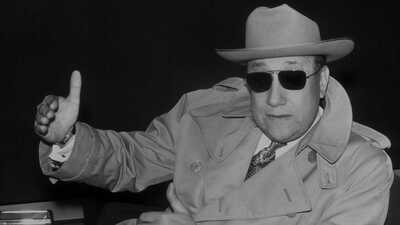Melville’s antiheroes (primarily in his noirs) are bathed in disciplines, morals, and strategies. They endure surveillance from authoritative and bureaucratic forces. To lead up to the 4K restoration release of his French Resistance classic “Army of Shadows” on August 2, Film Forum will host a 13-film “Complete Melville” retrospective filled with the director’s crime thrillers, adaptations of Francophonic literature, and World War II dramas from July 26 – August 1.
Born in a middle-class Alsatian Jewish family and with the surname Grumbach, Melville received a Pathe Baby camera for his birthday. Soon, he made a short film of his socialist father, mother, siblings, and home in Chaussee-d’Antin (his home for 16 years). It was in the moment “that I made my debut as a filmmaker and decided on my path,” Melville said in a 1970 interview with Variances. Like Cahiers du Cinema critics François Truffaut, Jean Luc Godard, and Claude Chabrol, Melville learned how to make movies by watching them. Until 1937 or 1938, he caught five movies a day. Film was his only interest as he would rather be in a theater “with a pocket full of diamonds” than be somewhere else for a day job, even after Melville’s brother Jacques and his wife helped him get a Diamond Deliverer gig following several errands from his job hunting. After Melville’s boss discovered his whereabouts, he was justifiably fired.
Melville soon hung out with gangsters he knew at the Saint-Lazare train station and befriended Paris’s “hoods” (e.g. high school dropouts). It was his relationships with a few gangsters, admiration for American gangster films, and preserving memories of a pre-war Pigalle that inspired Melville in leading France’s heist cinema. In Melville’s first foray into film noir (fourth overall feature), “Bob le Flambeur,” he hired actor Ruger Duchesne to play the eponymous anti-hero out of prison after the previously seasoned character actor was incarcerated for gambling debts. The down-on-his-luck Bob assembles a group of crooks to steal 800 million francs from a Deauville casino. Duchesne has an enlightening bounce as Bob in this “no[n-]pure policier, but a comedy of manners,” Melville’s words on the film. Still, its gleeful observation of luck and fate make it not as bleak as Melville’s later crime dramas. Bob gambles on horse racing bets but can’t always follow and build up his hot streak. With Melville’s signature jump cuts and unreliable narration, the film would become a box office hit and motivated French cinema’s next generation, Nouvelle Vague.
Americanophile is integral to Melville’s trajectory and his characterizations. When the French Resistance interrogated Melville in 1943, the past Resistance member told them that his last name was Melville, alluding to “Moby Dick” author Herman Melville, and not Grumbach. Because of his roots and passion for the mainstream, he infused and inverted Classic Hollywood rules (wipe cuts, fades, linear storytelling, etc.) into his films. It also contributed to his assimilation into the larger English world, where he wouldn’t have to face judgment for revealing his Jewish background. Inspired by Basil Dearden’s “Sapphire,” Melville’s next film was “Two Men in Manhattan.” It follows journalists Moreau (Melville in his only starring role just before his significant “Breathless” cameo as the interviewee) and photographer Delmas (Pierre Grasset) solving the mysterious disappearance of UN French delegate Fèvre-Berthier. Filmed in studios in France with exteriors in NYC, Moreau and Delmas gathered intel from the Midtown building’s versatile tenants at a theater, hospital, and photo lab.

